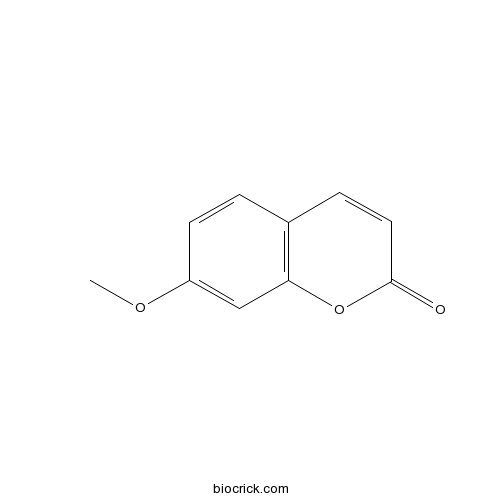Artemisia lactiflora
Artemisia lactiflora
1. The products in our compound library are selected from thousands of unique natural products; 2. It has the characteristics of diverse structure, diverse sources and wide coverage of activities; 3. Provide information on the activity of products from major journals, patents and research reports around the world, providing theoretical direction and research basis for further research and screening; 4. Free combination according to the type, source, target and disease of natural product; 5. The compound powder is placed in a covered tube and then discharged into a 10 x 10 cryostat; 6. Transport in ice pack or dry ice pack. Please store it at -20 °C as soon as possible after receiving the product, and use it as soon as possible after opening.
Natural products/compounds from Artemisia lactiflora
- Cat.No. Product Name CAS Number COA
-
BCN2707
7-Methoxycoumarin531-59-9
Instructions

[Chemical constituents of Artemisia lactiflora(II)].[Pubmed: 25276977]
To study the chemical constituents of Artemisia lactiflora. The compounds were isolated by column chromatography with silica gel, C18 reverse-phase silica gel, semi-preparative HPLC, and their structures were elucidated on the basis of spectral analysis. Twelve compounds were isolated from alcohol extracts of A. lactiflora and identified as 7-hydroxycoumarin (1), 7-methoxycoumarin (2), balanophonin (3), aurantiamide (4), aurantiamide acetate (5), isovitexin (6), kaempferol-3-O-beta-D-rutinoside (7), rutin (8), caffeic acid ethyl ester (9), quercetin (10), methyl 3, 5-di-O-caffeoyl quinate (11) and methyl 3, 4-di-O-caffeoyl quinate (12), respectively. Compounds 3-12 were obtained from this plant for the first time.
[Screening and taxonomic identification of endophytic fungi with antitumor and antioxidant activities from Artemisia lactiflora].[Pubmed: 24946544]
Artemisia lactiflora is an important medicinal plant in China. The antitumor and antioxidant activities of the extracts of 54 endophytic fungi from the plant were screened via MTT assay and DPPH scavenging radical assay, respectively. The bioactive strains were identified based on similarity of 5.8S gene and internal transcribed spacer (ITS) sequences. The results showed that extracts from ten (18.5%) isolates exhibited antitumor activity, and which from two (3.7%) isolates exhibited antioxidant activity. The Alternaria sp. GYBH47 strain was simultaneously having antagonistic activity against HL-60 leukemia, MCF-7 breast and COLO205 colon cell lines, and Phomopsis sp. GYBH42 strain having cytotoxic and antioxidant activities. The results indicated that endophytic fungi from Artemisia lactiflora are potential resources to find valuable bioactive components.
Antioxidant activity in extracts of 27 indigenous Taiwanese vegetables.[Pubmed: 24858497]
The objectives of this study were to identify the antioxidants and antioxidant axtivity in 27 of Taiwan's indigenous vegetables. Lycium chinense (Lc), Lactuca indica (Li), and Perilla ocymoides (Po) contained abundant quercetin (Que), while Artemisia lactiflora (Al) and Gynura bicolor (Gb) were rich in morin and kaempferol, respectively. Additionally, Nymphoides cristata (Nc) and Sechium edule (Se)-yellow had significantly higher levels of myricetin (Myr) than other tested samples. Cyanidin (Cyan) and malvidin (Mal) were abundant in Gb, Abelmoschus esculentus Moench (Abe), Po, Anisogonium esculentum (Retz.) Presl (Ane), Ipomoea batatas (Ib)-purple, and Hemerocallis fulva (Hf)-bright orange. Relatively high levels of Trolox equivalent antioxidant capacity (TEAC), oxygen radical absorption capacity (ORAC), and 1,1-diphenyl-2-picryl-hydrazyl (DPPH) radical scavenger were generated from extracts of Toona sinensis (Ts) and Po. Significant and positive correlations between antioxidant activity and polyphenols, anthocyanidins, Que, Myr, and morin were observed, indicating that these phytochemicals were some of the main components responsible for the antioxidant activity of tested plants. The much higher antioxidant activity of Po, Ts, and Ib (purple leaf) may be related to their higher Cyan, Que, and polyphenol content.
A diacetylenic spiroketal enol ether epoxide, AL-1, from Artemisia lactiflora inhibits 12-O-tetradecanoylphorbol-13-acetate-induced tumor promotion possibly by suppression of oxidative stress.[Pubmed: 10403539]
The inhibitory effects of the diacetylenic spiroketal enol ether epoxide AL-1 from Artemisia lactiflora on a variety of tumor promoter-induced biological responses such as oxidative stress as well as tumor promotion in ICR mouse skin were investigated. AL-1 inhibited TPA-induced intracellular peroxide formation in differentiated HL-60 cells, suggesting that this suppression might be attributable to the inhibition of O2- generation. In a double TPA application system in mouse skin, double pretreatments of AL-1 (810 nmol) significantly suppressed double TPA application-induced H2O2 generation. Pretreatment of AL-1 only before the second TPA treatment was sufficient to inhibit, while only with first treatment was not. From these results we concluded that AL-1 is a specific inhibitor of the activation phase in H2O2 production induced by double TPA treatments. In addition, AL-1 strongly inhibited tumor promoter-induced Epstein-Barr virus (EBV) activation in Raji cells (IC50 = 0.5 microM), which was comparable to or even stronger than that of curcumin, a well-known antioxidative chemopreventer from turmeric. In a two-stage carcinogenesis experiment with TPA (topical application at 1.6 nmol) and 7,12-dimethylbenz[a]anthracene (DMBA, at 0.19 micromol) in ICR mouse skin, topical application of AL-1 (at 160 nmol) significantly reduced tumor incidence, the numbers of tumors per mouse, and edema formation by 58% (P < 0.01 in t-test), 20% (P < 0.005 in chi2-test) and 42% (P < 0.01), respectively. These results together indicate that an inhibitor of O2 generation is an effective chemopreventer of mouse skin carcinogenesis by their antioxidative property.


